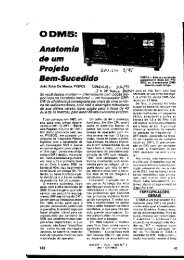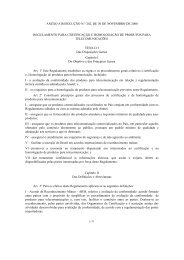A Software Defined Radio for the Masses, Part 3
A Software Defined Radio for the Masses, Part 3
A Software Defined Radio for the Masses, Part 3
You also want an ePaper? Increase the reach of your titles
YUMPU automatically turns print PDFs into web optimized ePapers that Google loves.
DSP code receives <strong>the</strong> captured signal<br />
and <strong>the</strong>n outputs <strong>the</strong> processed<br />
signal data.<br />
This article extends <strong>the</strong> sound-card<br />
interface to a functional SDR receiver<br />
demonstration. To accomplish this, <strong>the</strong><br />
following functions are implemented<br />
in software:<br />
• Split <strong>the</strong> stereo sound buffers into I<br />
and Q channels.<br />
• Conversion from <strong>the</strong> time domain<br />
Public Const Fs As Long = 44100 ‘Sampling frequency in samples per second<br />
Public Const NFFT As Long = 4096 ‘Number of FFT bins<br />
Public Const BLKSIZE As Long = 2048 ‘Number of samples in capture/play block<br />
Public Const CAPTURESIZE As Long = 4096 ‘Number of samples in Capture Buffer<br />
Public Const FILTERTAPS As Long = 2048 ‘Number of taps in bandpass filter<br />
Private BinSize As Single‘Size of FFT Bins in Hz<br />
Private order As Long ‘Calculate Order power of 2 from NFFT<br />
Private filterM(NFFT) As Double ‘Polar Magnitude of filter freq resp<br />
Private filterP(NFFT) As Double ‘Polar Phase of filter freq resp<br />
Private RealIn(NFFT) As Double ‘FFT buffers<br />
Private RealOut(NFFT) As Double<br />
Private ImagIn(NFFT) As Double<br />
Private ImagOut(NFFT) As Double<br />
Private IOverlap(NFFT - FILTERTAPS - 1) As Double ‘Overlap prev FFT/IFFT<br />
Private QOverlap(NFFT - FILTERTAPS - 1) As Double ‘Overlap prev FFT/IFFT<br />
Private RealOut_1(NFFT) As Double ‘Fast Convolution Filter buffers<br />
Private RealOut_2(NFFT) As Double<br />
Private ImagOut_1(NFFT) As Double<br />
Private ImagOut_2(NFFT) As Double<br />
Public FHigh As Long ‘High frequency cutoff in Hz<br />
Public FLow As Long ‘Low frequency cutoff in Hz<br />
Public Fl As Double ‘Low frequency cutoff as fraction of Fs<br />
Public Fh As Double ‘High frequency cutoff as fraction of Fs<br />
Public SSB As Boolean ‘True <strong>for</strong> Single Sideband Modes<br />
Public USB As Boolean ‘Sideband select variable<br />
Public TX As Boolean ‘Transmit mode selected<br />
Public IFShift As Boolean‘True <strong>for</strong> 11.025KHz IF<br />
Public AGC As Boolean ‘AGC enabled<br />
Public AGCHang As Long ‘AGC AGCHang time factor<br />
Public AGCMode As Long ‘Saves <strong>the</strong> AGC Mode selection<br />
Public RXHang As Long ‘Save RX Hang time setting<br />
Public AGCLoop As Long ‘AGC AGCHang time buffer counter<br />
Private Vpk As Double ‘Peak filtered output signal<br />
Private G(24) As Double ‘Gain AGCHang time buffer<br />
Private Gain As Double ‘Gain state setting <strong>for</strong> AGC<br />
Private PrevGain As Double ‘AGC Gain during previous input block<br />
Private GainStep As Double ‘AGC attack time steps<br />
Private GainDB As Double ‘AGC Gain in dB<br />
Private TempOut(BLKSIZE) As Double ‘Temp buffer to compute Gain<br />
Public MaxGain As Long ‘Maximum AGC Gain factor<br />
Private FFTBins As Long ‘Number of FFT Bins <strong>for</strong> Display<br />
Private M(NFFT) As Double ‘Double precision polar magnitude<br />
Private P(NFFT) As Double ‘Double precision phase angle<br />
Private S As Long ‘Loop counter <strong>for</strong> samples<br />
Figure 2 – Variable Declarations<br />
2 Nov/Dec 2002<br />
into <strong>the</strong> frequency domain using<br />
a fast Fourier trans<strong>for</strong>m (FFT).<br />
• Cartesian-to-polar conversion of <strong>the</strong><br />
signal vectors.<br />
• Frequency translation from <strong>the</strong> 11.5<br />
kHz-offset baseband IF to 0 Hz.<br />
• Sideband selection.<br />
• Band-pass filter coefficient generation.<br />
• FFT fast-convolution filtering.<br />
• Conversion back to <strong>the</strong> time domain<br />
with an inverse fast Fourier trans<strong>for</strong>m<br />
(IFFT).<br />
• Digital automatic gain control (AGC)<br />
with variable hang time.<br />
• Transfer of <strong>the</strong> processed signal to<br />
<strong>the</strong> output buffer <strong>for</strong> transmit or<br />
receive operation.<br />
The demonstration source code may<br />
be downloaded from ARRLWeb. 3 The<br />
software requires <strong>the</strong> dynamic link<br />
library (DLL) files from <strong>the</strong> Intel











